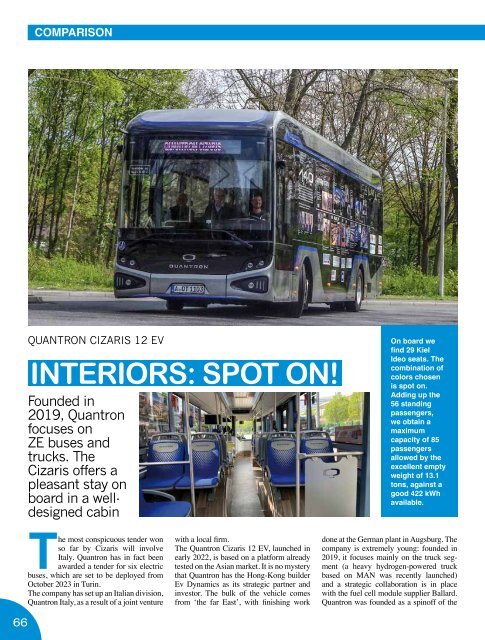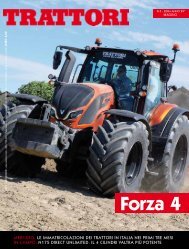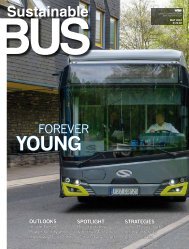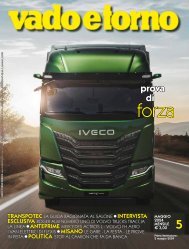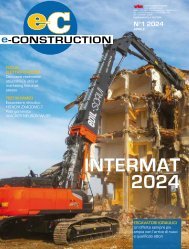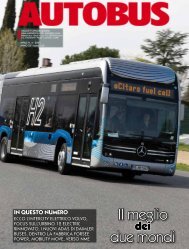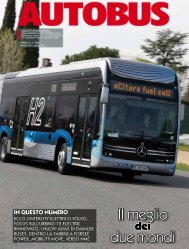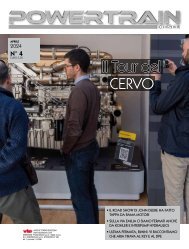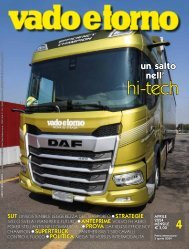2023-09 SUSTAINABLE BUS
A new issue of Sustainable Bus is out today. In this upcoming edition, we’ve curated a diverse and comprehensive range of topics that spotlight the latest developments in the world of sustainable mobility. From cutting-edge technological advancements to market insights and industry transformations, this issue promises to be a captivating exploration of the future of public transportation. What you could fine inside? Well, a market insight will offer you a detailed look at the European e-bus market, providing you with a comprehensive understanding of the mid-2023 results. The leading e-bus market in Europe is still UK: therefore, we focused our attention on that specific market with a report that sums up strategies, focus, goals of the most prominent industry players. A technology spotlight on the delicate topic of batteries, authored by Claudius Jehle, look at battery management and strategies to ensure the smooth and cost-effective operation of electric buses (with a focus on a case study from BVG). Among the pillars of our upcoming issue you’ll find a detailed journey around the European industrial bus&coach landscape. Goal? Providing our readers insights into the changing dynamics among key OEMs in the region. We’ll be then taking you behind the scenes at the Yutong factory in Zhengzhou, that we had the pleasure of visiting in June. Let’s then delve into Iveco Bus’s growing efforts in the zero-emission bus field. Finally, last but not least, a nearly-20-pages comparison between seven 12-meter battery-electric buses, gathered together in Bonn also this year by the German magazine Omnibusspiegel. You’ll find both established players and newcomers side by side: Ebusco 3.0, Hess lighTram 12m, Ikarus 120e, Iveco E-Way, Mercedes eCitaro with new batteries, Otokar e-Kent C, Quantron Cizaris 12 Ev.
A new issue of Sustainable Bus is out today. In this upcoming edition, we’ve curated a diverse and comprehensive range of topics that spotlight the latest developments in the world of sustainable mobility. From cutting-edge technological advancements to market insights and industry transformations, this issue promises to be a captivating exploration of the future of public transportation.
What you could fine inside? Well, a market insight will offer you a detailed look at the European e-bus market, providing you with a comprehensive understanding of the mid-2023 results. The leading e-bus market in Europe is still UK: therefore, we focused our attention on that specific market with a report that sums up strategies, focus, goals of the most prominent industry players.
A technology spotlight on the delicate topic of batteries, authored by Claudius Jehle, look at battery management and strategies to ensure the smooth and cost-effective operation of electric buses (with a focus on a case study from BVG).
Among the pillars of our upcoming issue you’ll find a detailed journey around the European industrial bus&coach landscape. Goal? Providing our readers insights into the changing dynamics among key OEMs in the region.
We’ll be then taking you behind the scenes at the Yutong factory in Zhengzhou, that we had the pleasure of visiting in June. Let’s then delve into Iveco Bus’s growing efforts in the zero-emission bus field.
Finally, last but not least, a nearly-20-pages comparison between seven 12-meter battery-electric buses, gathered together in Bonn also this year by the German magazine Omnibusspiegel. You’ll find both established players and newcomers side by side: Ebusco 3.0, Hess lighTram 12m, Ikarus 120e, Iveco E-Way, Mercedes eCitaro with new batteries, Otokar e-Kent C, Quantron Cizaris 12 Ev.
You also want an ePaper? Increase the reach of your titles
YUMPU automatically turns print PDFs into web optimized ePapers that Google loves.
COMPARISON<br />
QUANTRON CIZARIS 12 EV<br />
INTERIORS: SPOT ON!<br />
Founded in<br />
2019, Quantron<br />
focuses on<br />
ZE buses and<br />
trucks. The<br />
Cizaris offers a<br />
pleasant stay on<br />
board in a welldesigned<br />
cabin<br />
On board we<br />
find 29 Kiel<br />
Ideo seats. The<br />
combination of<br />
colors chosen<br />
is spot on.<br />
Adding up the<br />
56 standing<br />
passengers,<br />
we obtain a<br />
maximum<br />
capacity of 85<br />
passengers<br />
allowed by the<br />
excellent empty<br />
weight of 13.1<br />
tons, against a<br />
good 422 kWh<br />
available.<br />
Haller group, the historic Iveco workshop<br />
network in the DACH area.<br />
With the exception of the battery, most of<br />
the components come from Europe. The<br />
battery is offered in a series of capacity variants<br />
included in the ‘fork’ between 242<br />
and 424 kilowatt hours.<br />
The partnership with Dana<br />
The logo is that of the giant CATL, the chemistry,<br />
ça va sans dire, is LFP. The Dana/<br />
TM4 central motor mounted on the vehicle<br />
is water-cooled. Synchronous with permanent<br />
magnets, it features a continuous and<br />
maximum power of 145 and 245 kW respectively.<br />
The steering system is by Bosch.<br />
Dana’s signature also stands out on the<br />
axles: rigid at the front, portal at the rear.<br />
The model brought to Bonn has three doors,<br />
each 1,200 mm wide. Here again, the drive<br />
is pneumatic. On board we find 29 Kiel Ideo<br />
seats, the combination of colors chosen for<br />
the bus analyzed here is spot on. Adding up<br />
the 56 standing passengers, we obtain a maximum<br />
capacity of 85 passengers allowed<br />
by the excellent empty weight of 13.1 tons,<br />
against a good 422 kWh available.<br />
Here again, the air conditioning is a prerogative<br />
of the Valeo Revo E system, which is<br />
capable of releasing 29 kW in cooling and<br />
17 in heating. A 20 kW supplementary heating<br />
system is available.<br />
The pleasant interiors have already been<br />
mentioned, with a successful use of blue<br />
and yellow and a positive feeling of spaciousness<br />
(the feeling with the materials<br />
used is slightly less confident...). The decision<br />
to equip the rear of the bus with a row<br />
of seats arranged longitudinally, turned towards<br />
the rear door, in order to create a ninety-degree<br />
angle with the five-seater - which<br />
is surmounted by a large glazed surface (the<br />
batteries are on the roof) - was unprecedented.<br />
What about the driving area? Here<br />
again, the feeling is airy. Not particularly enveloping,<br />
it is closed on the right by a screen<br />
that transmits internal and external shots for<br />
security purposes. The launch of the 12-meter<br />
hydrogen-powered bus is expected in<br />
2024, with a motor, again by Dana, calibrated<br />
at 350 kW of peak power.<br />
The most conspicuous tender won<br />
so far by Cizaris will involve<br />
Italy. Quantron has in fact been<br />
awarded a tender for six electric<br />
buses, which are set to be deployed from<br />
October <strong>2023</strong> in Turin.<br />
The company has set up an Italian division,<br />
Quantron Italy, as a result of a joint venture<br />
with a local firm.<br />
The Quantron Cizaris 12 EV, launched in<br />
early 2022, is based on a platform already<br />
tested on the Asian market. It is no mystery<br />
that Quantron has the Hong-Kong builder<br />
Ev Dynamics as its strategic partner and<br />
investor. The bulk of the vehicle comes<br />
from ‘the far East’, with finishing work<br />
done at the German plant in Augsburg. The<br />
company is extremely young: founded in<br />
2019, it focuses mainly on the truck segment<br />
(a heavy hydrogen-powered truck<br />
based on MAN was recently launched)<br />
and a strategic collaboration is in place<br />
with the fuel cell module supplier Ballard.<br />
Quantron was founded as a spinoff of the<br />
66<br />
67


